Last week saw the launch of A Field Guide to “Fake News” and Other Information Disorders, a new free and open access resource to help students, journalists and researchers investigate misleading content, memes, trolling and other phenomena associated with recent debates around “fake news”.
The field guide responds to an increasing demand for understanding the interplay between digital platforms, misleading information, propaganda and viral content practices, and their influence on politics and public life in democratic societies.
Via Elizabeth E Charles, Miloš Bajčetić



 Your new post is loading...
Your new post is loading...











